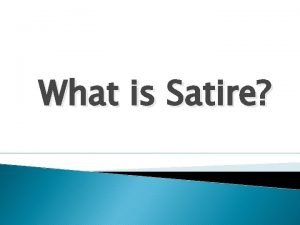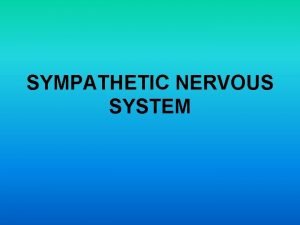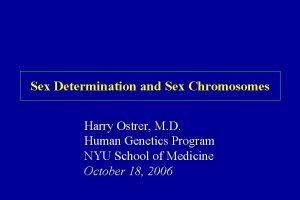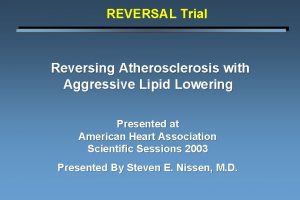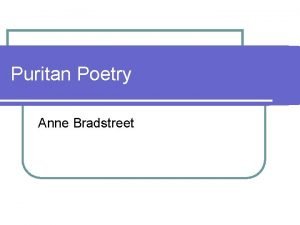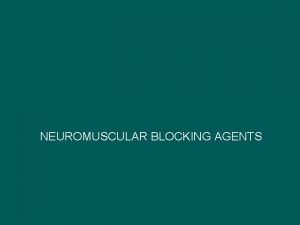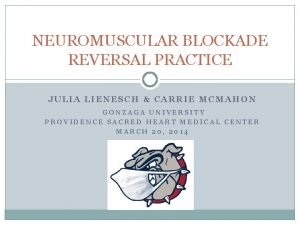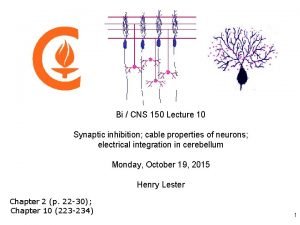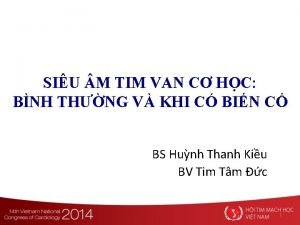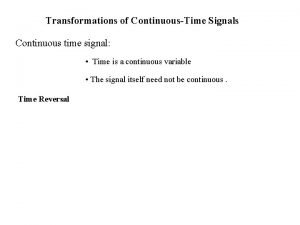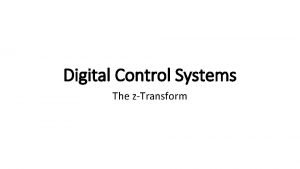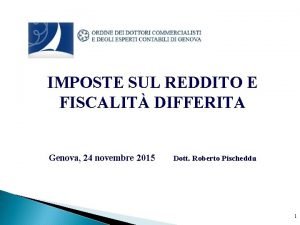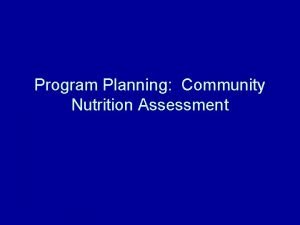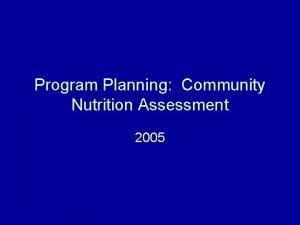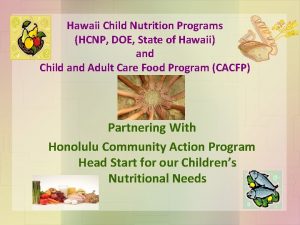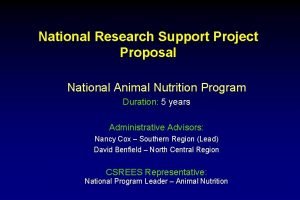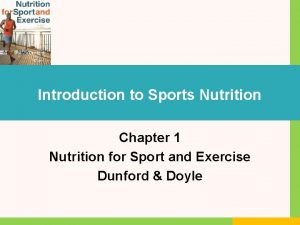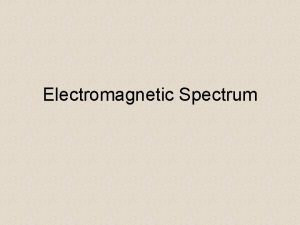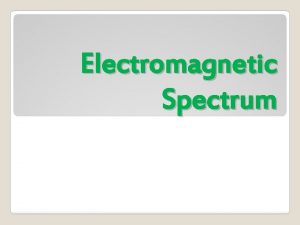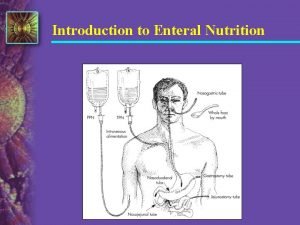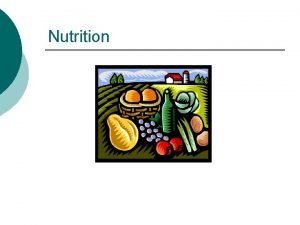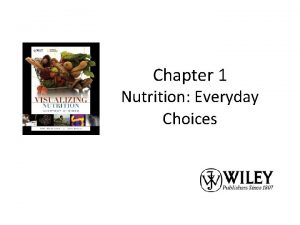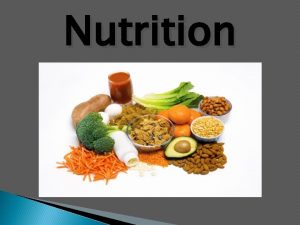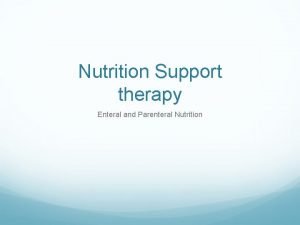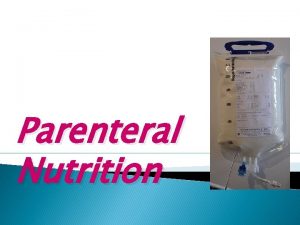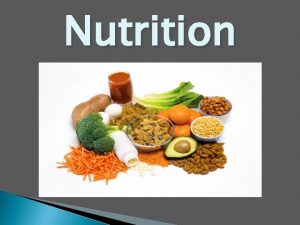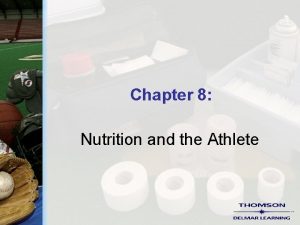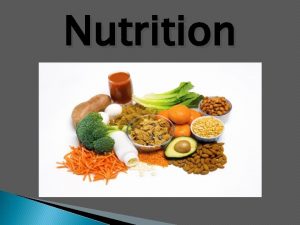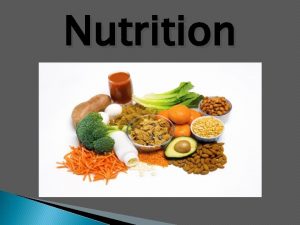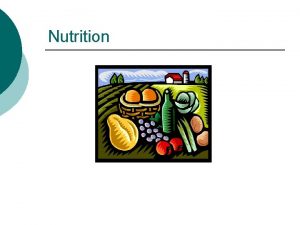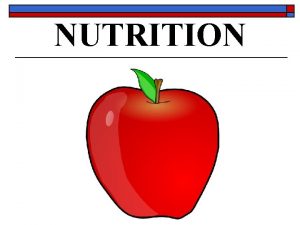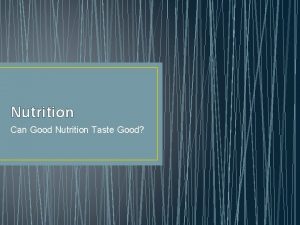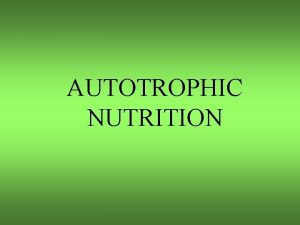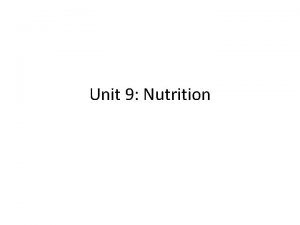Introduction to the Nutrition Spectrum Reversal Program Our























































- Slides: 55

Introduction to the Nutrition Spectrum Reversal Program

Our Goals For This Session • Discuss the typical American diet and its impact on heart disease risk • Provide an overview of a low-fat, plant based eating style and its health benefits • Describe the nutrition guidelines and the rationale • Introduce the Reversal Food Guide Pyramid • Describe the process of adjusting to the Nutrition Spectrum Reversal Program 2

What Is the Typical American Diet? 3

Fat and Animal Protein Sources In the Typical American Diet 4

The Average American Consumes… • • • 15 cows 12 hogs 900 chickens 12 sheep 1, 000 pounds of other assorted animals – Klaper, Michael MD. A Diet For All Reasons, 1992 5

The Results 6

Even Man’s Best Friend… • “FDA OKs Pfizer Drug For Obese Dogs” Fri Jan 5, 1: 59 PM – “The Food and Drug Administration said Friday it approved a Pfizer drug to help manage the weight of obese dogs. Pfizer will market Slentrol, a liquid formula, to the estimated 5 percent of U. S. dogs that are 20 percent over their ideal weight. In a statement issued Friday the FDA says the drug's "mechanism for producing weight loss is not completely understood, " but seems to cause less fat absorption. Overweight pets are more likely to develop heart disease, diabetes and joint problems, according to the government agency. According to Slentrol's labeling, a veterinarian must monitor the monthly weight change of a dog on the drug and adjust the dosage accordingly. ” (Cited from Associated Press) 7

What We Eat Impacts Our Health • • Coronary artery disease Stroke Certain cancers Diabetes Hypertension Overweight and obesity Osteoporosis 8

Nutrition and the Formation of Atherosclerotic Plaque 9

The Goals of the Dr. Dean Ornish Program For Reversing Heart Disease 10

An Integrated Approach to Reversing Heart Disease 11

Plant Versus Animal-Based Nutritional Programs • Studies world-wide have shown that populations eating a plant-based, low fat diet have… – – – – Less risk of heart disease Lower death rates from ischemic heart disease Less hypertension Less risk of type 2 diabetes Fewer intestinal disorders Less incidence of certain cancers Less risk for osteoporosis, kidney stones, and gallstones 12

Factors that Reduce Risk for Heart Disease • • Reduced saturated fat and cholesterol intake Higher fiber and antioxidant intake Lower heme iron intake and lower iron stores Lower blood pressure Decreased tendency to form unwanted blood clots Reduced blood viscosity Higher folate intake 13

What is the Nutrition Spectrum Reversal Program? It is a plant-based, whole-foods eating style that emphasizes… • • • Whole Grains Vegetables Fruits Legumes and Beans Soy Fat-free Dairy/Egg Whites 14

Nutrition Spectrum Reversal Program Guidelines for Reversing Heart Disease • • • Fat Cholesterol Animal products Calories Refined Carbohydrates 15 Caffeine Sodium Alcohol Soy Nutrition Supplements

10% of TOTAL CALORIES from FAT • Nutritional programs that include 20 -30% of calories from fat, like the American Heart Association Diet, have been associated with heart disease progression. • NO REVERSAL OCCURS. 16

Achieve 10% FAT by: • Eliminating: ELIMINATE – Meat, Poultry, Fish, etc. – Avocados, Olives – Nuts, Seeds – Added Oils/Fats 17

Hidden Fat and Saturated Fat in Animal Based Products 18

Hidden Fat and Saturated Fat In Oils and Added Fats 19

Hidden Fat and Saturated Fat In Nuts, Seeds, Avocados 20

Choose Plant-Based Whole Foods 21

0 -10 mg Cholesterol per Day • Dietary cholesterol is related to the increased risk of heart disease. – This risk is separate from the risk of dietary fat. • The body makes all the cholesterol it requires. • Food sources of cholesterol are in excess of what the body needs. 22

Achieve 0 -10 mg Cholesterol Per Day by: • Eliminating: – Meat (all types) – Poultry (all types) – Fish (all types) – Animal products except for egg whites and fatfree dairy foods (0 to 2 servings/day) 23

Hidden Sources of Cholesterol In Food 24

Cholesterol Content of Dairy Foods 25

Eliminate Animal Products ELIMINATE • Animal products: – Contain fat, saturated fat and cholesterol in high concentrations – Contain animal protein and iron, which create an environment that increases heart disease risk – Reduce the consumption of other food components that protect against heart disease • EXCEPTION: Non-fat dairy and egg whites are allowed with limits 26

Protein Sources • Choose: – Egg whites as a source of protein – Fat-free dairy products (0 to 2 servings/day) for protein, calcium, riboflavin and vitamin B 12 – Plant-based sources for adequate protein 27

Eat Abundantly • Calories are not restricted unless overweight or not losing weight (if desired). • The Nutrition Spectrum – Reversal Program: – – Is rich in fiber and naturally low in calories per bite Increases satiety value with fewer calories Self-regulates calories without calorie counting Helps to gradually reach and maintain an healthy body weight – Promotes eating with awareness and portion control 28

An Integrated Approach • Regular exercise burns calories and reduces stress. • Stress management increases awareness of when you are hungry, how much you eat, and why you eat. • Group support improves social connections and communication skills. • Improved nutrition eliminates high-fat, calorie-dense foods. 29

Limit Refined Carbohydrates • • Angel food cake Fat-free frozen yogurt Fat-free sweets Table sugar Jelly Fat-free pudding Limit to 0 to 2 servings per day 30 LIMIT

Why limit refined carbohydrates? • Absorbed quickly into the bloodstream, and causes swings in blood sugar levels (i. e. highs and lows) • Source of empty calories (i. e. weight gain) • Can elevate triglycerides • Many contain hydrogenated or partially hydrogenated fats LIMIT 31

Replace Refined Carbohydrates with Complex or “Preferred” Carbohydrates Instead of: White Rice Choose: Brown Rice White Bread 100% Whole Wheat Bread White Pasta Whole Wheat Pasta Refined Cereals Whole Grain Cereals White Flour Whole Wheat Flour 32

Moderate Sodium Intake • Follow your doctor’s recommendation if you are medically restricted. • Only about 1/4 of the population is sensitive to sodium. – Individuals who are not sodium-sensitive can have moderate quantities of sodium. • Salt can add flavor to very low-fat vegetarian dishes, improving taste and making adherence to the eating style easier. 33

Sources Of Sodium Added at Naturally Processed the Occurring Foods Table in Foods 33% 34 33%

If Sodium Is Restricted • Use fresh herbs and spices instead of salt. • Choose sodium-free spices. • Use reduced-sodium soy sauces, vegetable broths and condiments. • Ask for foods to be prepared without added salt. • Use fresh lemon juice, other citrus, flavored vinegars, hot sauce and wine in cooking to enhance flavor. LIMIT 35

Caffeine-Free Living • Eliminate caffeinated and decaffeinated coffee, colas, chocolate and cocoa products, regular and decaffeinated teas as well as over-thecounter medications containing caffeine. • Choose grain-based coffee, herbal tea and naturally caffeine-free diet and regular soft drinks. ELIMINATE 36

Caffeine’s Effect on the Body • Increases stress hormone levels (epinephrine, norepinephrine and cortisol) • Interferes with stress management • Increases blood pressure • Increases frequency and severity of irregular heart beats • Increases stomach acid • Acts as a laxative • Promotes nervousness, restlessness, • May contribute to a shorter “fuse” 37

Caffeine Content of Common Beverages 38

Withdrawing from Caffeine • Gradually… – Take 1 -2 weeks to go caffeine free – Switch to lower caffeine sources – Reduce intake 1/2 to 1 cup at a time – Have caffeine-free substitutes available 39

Green Tea: An Exception to the Caffeine-Free Rule • Contains powerful antioxidants that may reduce the risk of chronic disease • Choose fresh brewed regular or naturally decaffeinated green tea. • Limit to no more than 2 cups/day. • Individuals with arrhythmias, elevated stress and/or taking certain medications should avoid green tea. • Coumadin and other blood thinning medications may need adjustment. 40

Alcohol In Small Amounts (But Not Encouraged) • If consumed at all, limit alcohol to 1 serving/day. • One serving equals: – 1. 5 ounces liquor – 4 ounces wine – 12 ounces beer LIMIT • Speak with your doctor about alcohol and possible adverse interactions with medications or medical conditions. 41

The Pros and Cons • Beneficial effects: – Moderate amounts may increase HDL cholesterol • Negative effects: – – – Direct toxic effect on heart muscle and other organs Source of “empty” calories Decreases the body’s ability to burn fat by about 1/3 Inhibits willpower and adherence to the diet Associated with increased rates of breast cancer and liver disease – Associated with increased accidental deaths 42

One Full-Fat Soy Product Per Day • Source of essential fatty acids (omega-3) • Isoflavones (plant chemicals unique to soybeans) have antioxidant properties, which may protect LDL from oxidation. • Soy isoflavones have favorable effects on blood vessel function. LIMIT 43

What is a Full-Fat Soy Product? • • Greater than 3 grams of fat/serving Naturally occurring fat derived from the soybean No added fat/oil Examples include: – Soymilk (1 cup; >3 grams of fat) – Tofu (1/2 cup) – Dry roasted soy nuts (1/4 cup) 44

Vitamin and Mineral Supplementation • Added insurance • Source of omega-3 fatty acids – Reduce risk of sudden cardiac death, prevent certain types of arrhythmias, decrease platelet stickiness/blood clots, decrease triglycerides • Source of antioxidants – Help to prevent oxidation of LDL cholesterol, the form of cholesterol that is most likely to deposit in the arteries 45

Required Supplements • MULTIVITAMIN 100% Daily Value with Minerals – With B 12 (24 mcg/day or 2. 4 mg) – Without Iron (Unless female of childbearing age) • OMEGA-3 FATTY ACID SOURCE (Fish Oil Capsules) – Approximately 600 mg EPA and 400 mg DHA per day for both women and men (Dosage typically found in 2 to 4 grams of fish oil capsules per day) – Choose cholesterol-free fish oil supplements. 46

Optional Supplements • FOLIC ACID • VITAMIN E 400 -1000 mcg/day no more than 100 IU/day – If taking a cholesterol-lowering statin medication, check with prescribing MD. • VITAMIN C • SELENIUM 1 -3 grams/day 100 -200 mcg/day 47

Food Sources First • Vitamin E – Unrefined cereal grains, wheat germ, spinach, green peas and corn • Vitamin C – Fruits and vegetables especially: peppers, sweet green and red peppers and hot red and green chili peppers, citrus fruits and juices, Brussels sprouts, cauliflower, cabbage, kale, collards, mustard greens, broccoli, spinach and strawberries 48

Food Sources First • Selenium – Plant foods are the major sources of selenium in most countries; amount depends on soil. – Primarily found in grains and vegetables. • Folic Acid – Dark green leafy vegetables (spinach, kale, mustard greens, escarole, arugula, beet greens, bok choy, dandelion greens, radicchio, Swiss chard), oranges, lentils, pinto beans, garbanzo beans, asparagus, orange 49

Nutrition Spectrum – Reversal Program: Summary • 0% of total calories from fat • 0 -10 mg cholesterol • No animal protein • Eat abundantly • Limit refined carbohydrates • • Sodium in moderation Caffeine-free living Alcohol in moderation 1 full-fat soy product per day • Nutrition supplements 50

51

Adjusting Well to a New Way of Eating • Short-term – Gas/bloating – Cramping/constipation – Headaches • Long-term – Fewer ups and downs – Desire to eat more frequently – Sustained energy throughout the day – Weight loss 52

Adjusting Well to New Feelings • • Empowerment and pride “Road less traveled” Anger Fear Guilt Inspiration Excitement 53

Upcoming Nutrition Discussions • Identifying Ornish friendly foods • Grocery store tour • Evaluating the Nutrition Spectrum Reversal Program • Cooking demonstrations • An integrated approach to weight management • Shopping and meal planning • Eating out, traveling, socializing • Advanced nutrition: calcium, phytochemicals and functional foods 54

Questions 55
 Chromium orbital configuration
Chromium orbital configuration Absortpion
Absortpion Thinking language and intelligence
Thinking language and intelligence Our census our future
Our census our future Longing for peace our world is troubled
Longing for peace our world is troubled Our life is what our thoughts make it
Our life is what our thoughts make it We bow our hearts
We bow our hearts Our census our future
Our census our future Our life is what our thoughts make it
Our life is what our thoughts make it Who is the poet of the poem money madness
Who is the poet of the poem money madness Our awareness of ourselves and our environment
Our awareness of ourselves and our environment Our awareness of ourselves and our environment is called
Our awareness of ourselves and our environment is called God our father christ our brother
God our father christ our brother Our future is in our hands quotes
Our future is in our hands quotes Our awareness of ourselves and our environment.
Our awareness of ourselves and our environment. Our awareness of ourselves and our environment
Our awareness of ourselves and our environment Technique of satire
Technique of satire Surprising reversal strategy
Surprising reversal strategy Vasomotor reversal of dale
Vasomotor reversal of dale Triploidy syndrome pictures
Triploidy syndrome pictures What is reversal transaction
What is reversal transaction Reversal trial
Reversal trial Reversal potential
Reversal potential Puritan style poem
Puritan style poem Neuromuscular blocking agents
Neuromuscular blocking agents Neostigmine atropine reversal
Neostigmine atropine reversal Permit easy reversal of actions
Permit easy reversal of actions Shrek satire worksheet
Shrek satire worksheet Time reversal test formula
Time reversal test formula Time reversal property of z transform
Time reversal property of z transform Reversal design
Reversal design Unit step function examples
Unit step function examples Reversal potential
Reversal potential Schneiderman 8 golden rules
Schneiderman 8 golden rules Suspense account
Suspense account Holodiastolic flow reversal
Holodiastolic flow reversal Sry gene y chromosome
Sry gene y chromosome Errors of complete reversal
Errors of complete reversal Cfl closed under reversal
Cfl closed under reversal Figure ground ambiguity examples
Figure ground ambiguity examples Dependency reversal
Dependency reversal Context free languages closure properties
Context free languages closure properties Signal reversal
Signal reversal Reversal of dwarfism is caused by which hormone
Reversal of dwarfism is caused by which hormone Dts
Dts Victor lempitsky
Victor lempitsky Trait reversal
Trait reversal Z-transform table
Z-transform table Differenze temporanee e permanenti
Differenze temporanee e permanenti Divorce poem
Divorce poem Nutrition program planning
Nutrition program planning Fish cut images
Fish cut images Community nutrition program planning
Community nutrition program planning Hawaii child nutrition program
Hawaii child nutrition program Project proposal in animal science
Project proposal in animal science Basic nutrition principles
Basic nutrition principles
















